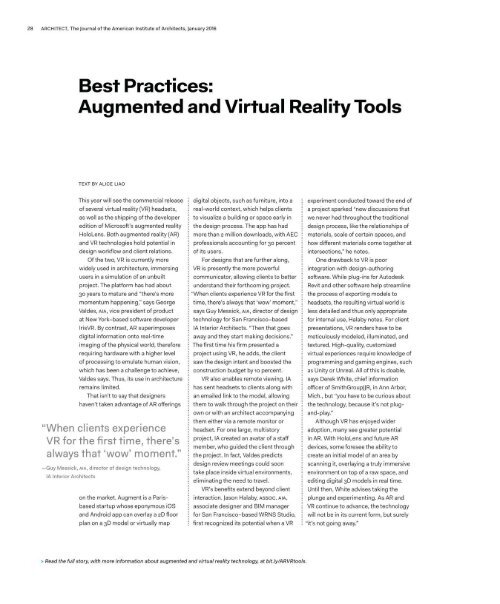Architect 2016-01
You also want an ePaper? Increase the reach of your titles
YUMPU automatically turns print PDFs into web optimized ePapers that Google loves.
28 ARCHITECT, The Journal of the American Institute of <strong>Architect</strong>s, January <strong>2<strong>01</strong>6</strong><br />
Best Practices:<br />
Augmented and Virtual Reality Tools<br />
TEXT BY ALICE LIAO<br />
This year will see the commercial release<br />
of several virtual reality (VR) headsets,<br />
as well as the shipping of the developer<br />
edition of Microsoft's augmented reality<br />
Hololens. Both augmented reality (AR)<br />
and VR technologies hold potential in<br />
design workflow and client relations.<br />
Of the two, VR is currently more<br />
widely used in architecture, immersing<br />
users in a simulation of an unbuilt<br />
project. The platform has had about<br />
30 years to mature and "there's more<br />
momentum happening," says George<br />
Valdes, AlA, vice president of product<br />
at New York-based software developer<br />
lrisVR. By contrast, AR superimposes<br />
digital information onto real-time<br />
imaging ofthe physical world, therefore<br />
requiring hardware with a higher level<br />
of processing to emulate human vision,<br />
which has been a challenge to achieve,<br />
Valdes says. Thus, its use in architecture<br />
remains limited.<br />
That isn't to say that designers<br />
haven't taken advantage of AR offerings<br />
"When clients experience<br />
VR for the first time, there's<br />
always that 'wow' moment."<br />
-Guy Messick, AlA, director of design technology,<br />
lA Interior <strong>Architect</strong>s<br />
on the market. Augment is a Parisbased<br />
startup whose eponymous iOS<br />
and Android app can overlay a 2D floor<br />
plan on a 3D model or virtually map<br />
digital objects, such as furniture, into a<br />
real-world context, which helps clients<br />
to visualize a building or space early in<br />
the design process. The app has had<br />
more than 2 million downloads, with AEC<br />
professionals accounting for 30 percent<br />
of its users.<br />
For designs that are further along,<br />
VR is presently the more powerful<br />
communicator, allowing clients to better<br />
understand their forthcoming project.<br />
"When clients experience VR for the first<br />
time, there's always that 'wow' moment,"<br />
says Guy Messick, AlA , director of design<br />
technology for San Francisco-based<br />
lA Interior <strong>Architect</strong>s. "Then that goes<br />
away and they start making decisions."<br />
The first time his firm presented a<br />
project using VR , he adds, the client<br />
saw the design intent and boosted the<br />
construction budget by 10 percent.<br />
VR also enables remote viewing. lA<br />
has sent headsets to clients along with<br />
an emailed link to the model, allowing<br />
them to walk through the project on their<br />
own or with an architect accompanying<br />
them either via a remote monitor or<br />
headset. For one large, multistory<br />
project, lA created an avatar of a staff<br />
member, who guided the client through<br />
the project. In fact, Valdes predicts<br />
design review meetings could soon<br />
take place inside virtual environments,<br />
eliminating the need to travel.<br />
VR 's benefits extend beyond client<br />
interaction. jason Halaby, Assoc. AlA,<br />
associate designer and BIM manager<br />
for San Francisco-based WRNS Studio,<br />
first recognized its potential when a VR<br />
experiment conducted toward the end of<br />
a project sparked "new discussions that<br />
we never had throughout the traditional<br />
design process, like the relationships of<br />
materials, scale of certain spaces, and<br />
how different materials come together at<br />
intersections," he notes.<br />
One drawback to VR is poor<br />
integration with design-authoring<br />
software. While plug-ins for Autodesk<br />
Rev it and other software help streamline<br />
the process of exporting models to<br />
headsets, the resulting virtual world is<br />
less detailed and thus only appropriate<br />
for internal use, Halaby notes. For client<br />
presentations, VR renders have to be<br />
meticulously modeled, illuminated, and<br />
textured. High-quality, customized<br />
virtual experiences require knowledge of<br />
programming and gaming engines, such<br />
as Unity or Unreal. All of this is doable,<br />
says Derek White, chief information<br />
officer of SmithGroupjJR, in Ann Arbor,<br />
Mich., but "you have to be curious about<br />
the technology, because it's not plugand-play."<br />
Although VR has enjoyed wider<br />
adoption, many see greater potential<br />
in AR. With Hololens and future AR<br />
devices, some foresee the ability to<br />
create an initial model of an area by<br />
scanning it, overlaying a truly immersive<br />
environment on top of a raw space, and<br />
editing digital 3D models in real time.<br />
Until then, White advises taking the<br />
plunge and experimenting. As AR and<br />
VR continue to advance, the technology<br />
will not be in its current form, but surely<br />
"it's not going away."<br />
>Read the full story, with more information about augmented and virtual reality technology, at bit.ly!ARVRtoo/s.

















